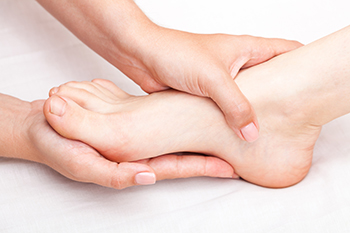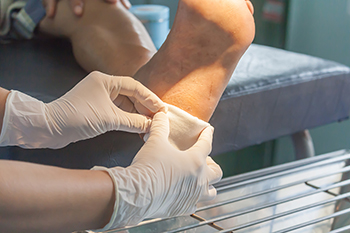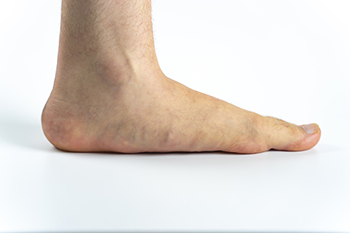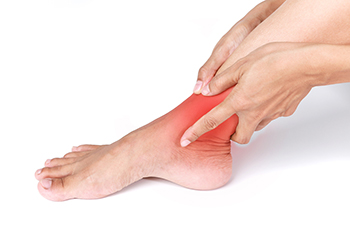Connect With Us
Blog
Pain Across the Top of the Foot

Tendonitis, or inflammation of a tendon, is common among runners as well as others who do a lot of running during sports activities. A particular brand of tendonitis that occurs across the top of the foot is typical of overuse. It is known as extensor tendonitis, and affects the three tendons that connect the leg bones to the bones in the feet that allow you to walk and run. Symptoms include aching pain that worsens through activity. Some swelling may occur, and curling the toes usually adds to the pain as the tendons are stretched. Besides overuse, other factors to address include your footwear and training regime. Running shoes that fit poorly and are tied too tightly contribute to the pressure on the top of the foot. Also, changing your training program to include running up and down hills can negatively affect the extensor tendons. The first action to take against extensor tendonitis is to stop the activity. For other treatment options, it is wise to see a podiatrist who will be able to evaluate the severity of your condition and provide the appropriate solutions.
Foot Pain
Foot pain can be extremely painful and debilitating. If you have a foot pain, consult with one of our podiatrists from Foot & Ankle Associates of Maine. Our doctors will assess your condition and provide you with quality foot and ankle treatment.
Causes
Foot pain is a very broad condition that could be caused by one or more ailments. The most common include:
- Bunions
- Hammertoes
- Plantar Fasciitis
- Bone Spurs
- Corns
- Tarsal Tunnel Syndrome
- Ingrown Toenails
- Arthritis (such as Gout, Rheumatoid, and Osteoarthritis)
- Flat Feet
- Injury (from stress fractures, broken toe, foot, ankle, Achilles tendon ruptures, and sprains)
- And more
Diagnosis
To figure out the cause of foot pain, podiatrists utilize several different methods. This can range from simple visual inspections and sensation tests to X-rays and MRI scans. Prior medical history, family medical history, and any recent physical traumatic events will all be taken into consideration for a proper diagnosis.
Treatment
Treatment depends upon the cause of the foot pain. Whether it is resting, staying off the foot, or having surgery; podiatrists have a number of treatment options available for foot pain.
If you have any questions, please feel free to contact our office located in Brunswick, ME . We offer the newest diagnostic and treatment technologies for all your foot care needs.
The Senior Population and Foot Wounds

Wounds on the feet can be a common occurrence for much of the population, and they can be a serious concern among the elderly. This can be a result of diminished blood flow in the feet and immediate medical attention may help to avoid potential problems. Effective wound prevention can include moisturizing the feet and drinking plenty of fresh water daily. Additionally, it may help to take a multivitamin that is designed to protect the skin. The skin color may turn when a wound is present, and a clean environment is needed for successful wound healing. This is followed by using a non-adherent dressing and placing a cushioned bandage over the wound. A pressure ulcer is a common type of wound that elderly people may develop. This often happens as a result of pressure that occurs over a bone. If you would like more information about types of foot wounds and how to treat them, it is strongly suggested that you confer with a podiatrist.
Wound care is an important part in dealing with diabetes. If you have diabetes and a foot wound or would like more information about wound care for diabetics, consult with one of our podiatrists from Foot & Ankle Associates of Maine. Our doctors will assess your condition and provide you with quality foot and ankle treatment.
What Is Wound Care?
Wound care is the practice of taking proper care of a wound. This can range from the smallest to the largest of wounds. While everyone can benefit from proper wound care, it is much more important for diabetics. Diabetics often suffer from poor blood circulation which causes wounds to heal much slower than they would in a non-diabetic.
What Is the Importance of Wound Care?
While it may not seem apparent with small ulcers on the foot, for diabetics, any size ulcer can become infected. Diabetics often also suffer from neuropathy, or nerve loss. This means they might not even feel when they have an ulcer on their foot. If the wound becomes severely infected, amputation may be necessary. Therefore, it is of the upmost importance to properly care for any and all foot wounds.
How to Care for Wounds
The best way to care for foot wounds is to prevent them. For diabetics, this means daily inspections of the feet for any signs of abnormalities or ulcers. It is also recommended to see a podiatrist several times a year for a foot inspection. If you do have an ulcer, run the wound under water to clear dirt from the wound; then apply antibiotic ointment to the wound and cover with a bandage. Bandages should be changed daily and keeping pressure off the wound is smart. It is advised to see a podiatrist, who can keep an eye on it.
If you have any questions, please feel free to contact our office located in Brunswick, ME . We offer the newest diagnostic and treatment technologies for all your foot care needs.
Do I Have Flat Feet?

The medical term for fallen arches or flat feet is known as pes planus. It is noticeable when the foot lies flat on the floor, and the arch is absent. Some patients do not have symptoms, or may experience mild pain or achiness in different parts of the leg. Most people are born with flat feet, and the arch generally forms in the teenage years. This condition may develop from genetic reasons, obesity, or possibly from a foot injury. Additionally, a dysfunction of one or more of the muscles in the foot may lead to flat feet. It is beneficial for patients who have flat feet to wear shoes that are supportive, and this may help to prevent future injuries. People who have flat feet are advised to consult with a podiatrist who can offer custom-made orthotics for relief.
Flatfoot is a condition many people suffer from. If you have flat feet, contact one of our podiatrists from Foot & Ankle Associates of Maine. Our doctors will treat your foot and ankle needs.
What Are Flat Feet?
Flatfoot is a condition in which the arch of the foot is depressed and the sole of the foot is almost completely in contact with the ground. About 20-30% of the population generally has flat feet because their arches never formed during growth.
Conditions & Problems:
Having flat feet makes it difficult to run or walk because of the stress placed on the ankles.
Alignment – The general alignment of your legs can be disrupted, because the ankles move inward which can cause major discomfort.
Knees – If you have complications with your knees, flat feet can be a contributor to arthritis in that area.
Symptoms
- Pain around the heel or arch area
- Trouble standing on the tip toe
- Swelling around the inside of the ankle
- Flat look to one or both feet
- Having your shoes feel uneven when worn
Treatment
If you are experiencing pain and stress on the foot you may weaken the posterior tibial tendon, which runs around the inside of the ankle.
If you have any questions please feel free to contact our office located in Brunswick, ME . We offer the newest diagnostic and treatment technologies for all your foot and ankle needs.
Why Your Ankle May Hurt Without an Injury

Ankle pain that is sudden, and not due to an injury, may be caused by any number of causes, including certain arthritic conditions. Rheumatoid arthritis and osteoarthritis can sometimes negatively affect the tissue and cartilage (respectively) in ankles, causing pain and swelling. Similar symptoms can be present when reactive arthritis affects the ankle. This is a condition which is triggered by a bacterial infection elsewhere in the body. Gout is another type of arthritis in which excessive amounts of uric acid crystalize on joints. Gout usually affects the big toe, but it can also affect the ankle. Another disease that sometimes affects the ankle joint causing stiffness, pain and swelling is scleroderma. Bursitis is a condition in which the cushioning bursa sac at the back of the ankle becomes inflamed from stress or overuse and produces pain and inflammation. If you rupture or tear the tendon that connects your calf muscle with your heel (Achilles tendon), you can develop a condition known as Achilles tendonitis. These are just a few of the conditions that may cause ankle pain without injury. Whatever the cause, it is important to have your ankle pain properly diagnosed in order to receive the proper treatment. Call a podiatrist if you are experiencing any pain in your ankle.
Ankle pain can be caused by a number of problems and may be potentially serious. If you have ankle pain, consult with one of our podiatrists from Foot & Ankle Associates of Maine. Our doctors will assess your condition and provide you with quality foot and ankle treatment.
Ankle pain is any condition that causes pain in the ankle. Due to the fact that the ankle consists of tendons, muscles, bones, and ligaments, ankle pain can come from a number of different conditions.
Causes
The most common causes of ankle pain include:
- Types of arthritis (rheumatoid, osteoarthritis, and gout)
- Ankle sprains
- Broken ankles
- Achilles tendonitis
- Achilles tendon rupture
- Stress fractures
- Bursitis
- Tarsal tunnel syndrome
- Plantar fasciitis
Symptoms
Symptoms of ankle injury vary based upon the condition. Pain may include general pain and discomfort, swelling, aching, redness, bruising, burning or stabbing sensations, and/or loss of sensation.
Diagnosis
Due to the wide variety of potential causes of ankle pain, podiatrists will utilize a number of different methods to properly diagnose ankle pain. This can include asking for personal and family medical histories and of any recent injuries. Further diagnosis may include sensation tests, a physical examination, and potentially x-rays or other imaging tests.
Treatment
Just as the range of causes varies widely, so do treatments. Some more common treatments are rest, ice packs, keeping pressure off the foot, orthotics and braces, medication for inflammation and pain, and surgery.
If you have any questions please feel free to contact our office located in Brunswick, ME . We offer the newest diagnostic tools and technology to treat your foot and ankle needs.
